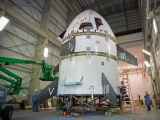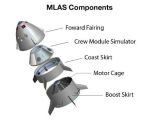Yesterday morning, NASA finally tested its alternate launch abort system, at the Wallops Flight Facility, in Wallops Island, Virginia. The Max Launch Abort System, or MLAS, simulated flight took place at 6:26 am local time, and ran smoothly, officials confirm. The device offers more security and survivability to astronauts who want to or have to abandon their spacecraft. The MLAS differs from other launch abort systems in that it uses a bullet-shaped enclosure and four rocket boosters to simply jet the astronauts away from any problems with their carrier spacecraft, delivery system, or launch pad.
MLAS in itself is not capable of powered flight. The passively stabilized launch abort system deploys rigid or flexible flight fins, which help guide it to safety. The astronauts inside the crew module, which will be affixed right on top of the MLAS, will have no control over them, but NASA believes that this won't be necessary. That is to say, after the stage's four rocket boosters burn off, it will deploy a series of parachutes that will allow for a smooth and safe descent back on the ground.
“The 33-foot-high MLAS vehicle was launched to an altitude of approximately one mile to simulate an emergency on the launch pad. The flight demonstration began after the four solid rocket motors burned out. The crew module mock-up separated from the launch vehicle at approximately seven seconds into the flight and parachuted into the Atlantic Ocean,” a press release on NASA's official website says.
“The test demonstrated a number of things: the un-powered flight of the MLAS along a stable trajectory; reorientation and stabilization of the MLAS; separation of the crew module simulator from the abort motors; and stabilization and parachute recovery of the crew module simulator. An important objective of the test was to provide the workforce of NASA's Engineering and Safety Center, or NESC, with experience in flight testing a spacecraft concept,” it further pinpoints.
In addition to successfully ensuring that a potential crew would be safe from unforeseen circumstances, the test also allowed experts at the American space agency to collect invaluable data, associated with the aerodynamics and the orientation of the module, and the forces that acted on the crew capsule and the MLAS itself.

 14 DAY TRIAL //
14 DAY TRIAL // 



